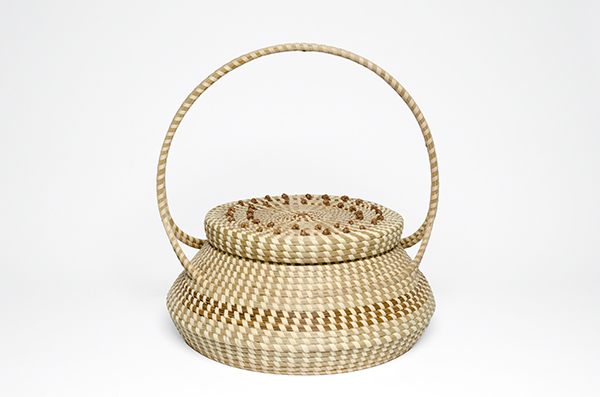Black History Month 2022: Mary A. Jackson
Mary A. Jackson is instrumental in bringing the African American tradition of sweetgrass basket making (called “Gullah” basketry) to international recognition. Sweetgrass basketry of the Lowcountry in South Carolina is one of the art forms that has a direct connection between the heritage of African American art and West African traditions.
 |
| Mary A. Jackson (born 1945, U.S.), Large Covered Box with Handle/French Knots, 2012. Sweetgrass, bulrush, pine needles, and palmetto, 16 5/16" x 17 5/16" x 16 1/8" (41.5 x 44 x 41 cm). Image courtesy of the Philadelphia Museum of Art. © 2022 Mary A. Jackson. (PMA-8023) |
Coiled baskets, unlike other basketry techniques, are the product of a sewn process. A bunch of grass forms the “bundle,” or foundation, of the basket. It is held together with the “binder” that is twined around it. The grass must be constantly replenished and the binder spliced so that a continuous row is produced. The preferred material for the foundation is sweetgrass or bulrush, both abundant in the Lowcountry. The foundation of this box is alternating sections of sweetgrass and bulrush.
While Jackson has produced many traditional basket forms, including fanners, she has pioneered in the production of more contemporary and unusual forms, such as this covered box with a slender, elegant handle. In her work, she has brought world-wide attention to the art form, using a silver spoon handle with the bowl removed as her main tool. She works intuitively, noting that her fingers can sense when to add more sweetgrass to the coil. She notes that her mother once told her to make art out of the sweetgrass, and so she has.
Coiled grass basketry is one of the most recognizable art forms in South Carolina. African Americans first produced the baskets in the late 1600s. Enslaved West Africans taken to America brought with them the skills that they learned in their homeland: pottery making, woodcarving, and basket making, just to name a few. As they did in Africa, they used the materials available to them in nature.
The production of coiled baskets is connected to the rise of rice cultivation in the South. By the mid-1700s, rice was the largest cash crop in South Carolina. Nine-tenths of the Southern rice crop was grown in South Carolina before the Civil War. The making of baskets went hand in hand with rice cultivation. The earliest grass baskets were fanners. The fanner was a wide winnowing basket that was used to toss the threshed and pounded grain into the air, allowing it to fall into another basket. As the rice fell, the wind removed the chaff. Up until the early 1900s, African American farmers produced crops of rice and processed it with fanner baskets.
After the Civil War, African Americans in the Lowcountry continued making a variety of baskets for household and farm use. Up until the 1900s, men primarily produced baskets, as they traditionally did in many African cultures. The function and forms of African American baskets changed markedly in the early 1900s when a group of basket makers in Mount Pleasant began to create “show” baskets for sale to tourists.
As agriculture declined in South Carolina, basket making became a major tourist cottage industry. Into the 21st century, most sweetgrass basket artists are women. Basket making is most often a family affair, with the men cutting the grass and the women producing the baskets. To this day, baskets made in South Carolina closely resemble those produced in West Africa.
Jackson grew up outside of Charleston in Mount Pleasant. By the time Jackson was four, her mother and grandmother taught her the same weaving techniques that had been handed down for generations. Although Jackson moved to New York to work for an insurance company, she took up basket making again when she returned to South Carolina in the 1970s.
Even as a child, Jackson considered the weaving of grasses into useful basket forms a special talent. Aside from being a leader in the art form, Jackson works to ensure that the tradition continues in the Lowcountry. She maintains the tradition with her daughter and granddaughter, all three often working on a single basket. Jackson received a MacArthur Foundation fellowship in 2008, and her work is included in the collection of the National Museum of African American History and Culture.
Correlations to Davis programs: Explorations in Art 2E Grade 6: 4.4; A Community Connection 2E: 5.3; A Global Pursuit 2E: 2.5, Exploring Visual Design 4E: Unit 6 studio


Comments